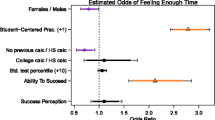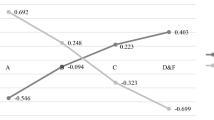Abstract
Students’ perception of the costs of engaging in learning has only recently been the focus of empirical study. Perceived costs include effort cost, opportunity cost, and psychological cost. This study focuses on the implications of psychological cost – the perceived negative psychological consequence of participating in a learning task –for learning behavior, performance, and the potentially greater prevalence of cost for women learning math. Research questions include: (1) Does perceived psychological cost of engaging in a calculus course predict undergraduates’ behavior in the learning management system (LMS)? (2) Does psychological cost of engaging in a calculus course predict students’ academic performance? (3) Which digital learning behaviors predict final exam score? (4) Do females perceive greater psychological cost than males? (5) Are there differences in course achievement by gender? And (6) Do male and females’ digital learning behaviors differ? Contrasting theory and prior findings, psychological cost did not predict learning behavior or course performance. Students’ use of policy documents and a tool to organize study sessions predicted final exam performance. Females perceived greater psychological costs than males when studying calculus, consistent with prior research. Female students also scored lower than males on the final exam. Results suggest that costs may differ by gender and may mediate gender differences in performance.
You have full access to this open access chapter, Download conference paper PDF
Similar content being viewed by others
Keywords
1 Theoretical Framework and Background
1.1 Expectancy Value Theory
Motivation theories attempt to explain why individuals choose different tasks that they want to engage, how long they engage in those tasks, how intensive their engagement is, and what are their interpretations about task performance and goals (Eccles et al. 1998). Expectancy Value Theory (EVT) is one of the perspectives explaining motivation, arguing that individuals’ expectations on the performance of tasks and their perceived value of tasks explain their choices and persistence on tasks as well as the vigor in carrying them out (Eccles et al. 1983). According to EVT model, expectancies and values are influenced by an array of psychological and social cultural determinants, such as beliefs of individuals’ abilities, the perceived difficulty of different tasks, task goals, self-schema, and affective memories. Expectancy in the modern EVT is defined as the expectancies for success, which distinguishes from the beliefs about competence or ability (Wigfield et al. 2010). Task values in EVT consists of four major components: attainment value, intrinsic value, utility value, and cost. Attainment value can be understood as the personal importance of doing well on the task, intrinsic value is the enjoyment one gains from doing the task, utility value refers to how the current task benefits individuals’ future plans, and cost refers to the negative aspects of engaging the task, such as performance anxiety or fear of failure. This study examines students’ perceived cost, in particular, psychological cost in taking Calculus I, and how the psychological cost influence learning behaviors and the learning outcome.
1.2 The Role of Cost
Within EVT, cost is defined as “what an individual has to give up to do a task, as well as the anticipated effort one will need to put into task completion” (Eccles 2005). If a task is perceived as costing too much, individuals will be less likely to do it. EVT theorists hypothesized three types of cost: opportunity cost, effort cost, and psychological cost. Opportunity cost is how much alternatives one needs to give up in order to engage in the task, effort cost is how much effort will be needed to accomplish the task, and psychological cost refers to the negative psychological or emotional consequence of participating this task. Gaspard et al. (2015) found that females perceive more psychological and effort cost than males using a measure of cost found to be invariant between males and females.
Conceptualized as the mediator between individuals’ affective reactions and performance, cost was introduced as one of the components of task values, along with attainment value, intrinsic value, and utility value (e.g. Barron and Hulleman 2015; Eccles et al. 1983; Eccles et al. 1998; Wigfield and Eccles 1992, 2000). Studies have shown that cost is empirically different from expectancies and values (Conley 2012; Kosovish et al. 2015; and Trautwein et al. 2012). Flake et al. (2015) extended these methodological confirmations and further elevated the treatment of cost and established costs as factors that influences outcomes alongside values, rather than as a subcomponent of values.
Prior empirical studies that examine cost as a component of value, primarily find that values were positively predict students’ academic choices such as switching STEM majors (Perez et al. 2014) and enrollment intentions in math courses (Meece et al. 1990). In the studies that also measure perceived cost as an independent construct, perceived cost was found to negatively predict academic choice (Battle and Wigfield 2003). Barron and Hulleman (2015) also reported that students’ value predicted their interest in the subject, but perception of cost can negative predict both their grades and interests in the subject. Debate continues: Barron and Hulleman (2015) proposed an expectancy-value-cost motivation model after a comprehensive review of the literature while Wigfield et al. (2017) maintain the argument that cost should not be elevated to a named component in Expectancy Value Theory. This study applies a contextual approach given prior evidence of the psychological variables previously shown to influence students engagement and achievement in undergraduate mathematics. We thus focus our examination on the implications of psychological cost across students, and focus further on its implications for the female students most apt to abandon their STEM career aspirations.
2 Methods
The primary purpose of this study is to examine the role of psychological cost in students’ learning behaviors and outcomes in a face-to-face Calculus course in a Southwestern university. In addition, this study also seeks to answer whether or not there is discrepancy of psychological cost between female students and male students.
2.1 Research Questions
-
1.
Does perceived psychological cost of engaging in a calculus course predict undergraduates’ behavior in a learning management system (LMS)?
-
2.
Does perceived psychological cost of engaging in a calculus course predict students’ academic performance?
-
3.
Which digital learning behaviors predict final exam scores?
-
4.
Do females perceive greater psychological cost than males?
-
5.
Are there differences in course achievement by gender?
-
6.
Do male and females’ digital learning behaviors differ?
2.2 Participants and Course
One hundred and twenty one undergraduate students (53% female; 33% Caucasian, 23% Asian, 20% Hispanic, and 24% others; 55% first generation college students) taking Calculus I in a Southwestern U.S. university participated in this study. Learning behaviors in the LMS were collected from server logs for two face-to-face Calculus course sections taught by instructors that hosted digital course content on their LMS course site.
2.3 Measures
Learning Behaviors.
Eight kinds of students’ learning behaviors are recorded. We traced and collected those learning behaviors explained by how frequently they clicked on the links (see Table 1).
Perceived Psychological Cost.
Questionnaires assessing expectancies, attainment, intrinsic and utility value and effort, opportunity and psychological costs were adapted from Perez et al. (2014) and administered in weeks (4 items per value and cost; six-point Likert scale; Table 2).
Learning Outcome.
A final exam provided a summative evaluation of students’ learning in the course. This culminating exam assessed all course objectives and was composed of multiple choice and constructed response items. The majority of items were math problems to be solved. Some included prompts to provide written responses explaining concepts and procedures. These were scored using a standard rubric employed by multiple raters.
3 Results
Research Question 1: Does perceived psychological cost of engaging in a calculus course predict undergraduates’ behavior in a learning management system (LMS)?
A series of multiple regression analysis regressing students’ LMS behaviors on their level of perceived psychological cost revealed no significant predictive relationship, Fs(3,115) < 2.69, ps > .05.
Research Question 2: Does perceived psychological cost of engaging in a calculus course predict students’ academic performance?
A multiple regression analysis regressing exam scores on values and costs produced a nonsignificant omnibus model, F(6,113) = 1.141, p = .217. In this model, psychological cost was not a significant predictor of exam scores, β = −.166, p = .125.
Research Question 3: Which digital learning behaviors predict final exam scores?
A model regressing final exam score on students’ behaviors was statistically significant, F(8, 110) = 2.491, p < .05, R2 = .016. Accesses to an interactive tool designed to organize study session (b = .013, SE = .007, p < .05, β = .178) and to policy documents (b = .012, SE = .004, p < .01, β = .293) predicted final exam grade.
Research Question 4: Do female perceive greater psychological cost than males?
In an independent samples t-test demonstrated variances were similar across groups (F = .531, p = .468) and that females students perceived significantly greater psychological cost when learning calculus than male students, t(119) = 2.632, p = .010, d = .48.
Research Question 5: Are there differences in course achievement by gender?
A second independent samples t-test demonstrated variances were similar across groups (F = .380, p = .54) and that males outperformed females on the final exam, t(119) = −2.599, p = .011, d = .48.
Research Question 6: Any gender differences on learning behaviors?
After a series of t-test, we did not observe significant gender differences on learning behaviors, ts < .381, ps > .05.
4 Discussion and Conclusion
This study builds on recent expectancy value theory research and examined the psychological cost induced when learning calculus, its relation to learning behaviors and achievement, as well as differences by gender. Results contrasted with theory and recent research and indicated psychological cost did not significantly predict behaviors or achievement.
Findings regarding the role of cost differ from EVT theory and previous studies of such relations. Prior research has revealed that high perceived cost results in lower frequency of learning activity (Chiang et al. 2011) and that perceptions of cost predict learning outcomes (Barron and Hulleman 2015). Because the courses observed were two face-to-face courses, where students had the opportunity to work both online and offline, the behaviors observed may comprise only a subset of learning activities. They do however provide a valid, granular record of learning events (Bernacki 2018). These findings should be understood to reflect only technology-based behaviors but to do so with precision. The modest relationship between psychological cost and achievement (i.e., β = .17) was not statistically significant, and was considerably smaller than the more general relationship between cost and achievement (i.e., r = .30; Flake, Flake et al. 2015). It may be that psychological cost is less associated with achievement than effort or opportunity costs, but contextual factors may also influence this relationship.
Digital learning (e.g. organizing study and policy document use) predicted achievement in calculus. Whereas relations between psychological cost and learning behaviors were not observed, two behaviors – monitoring study sessions with an interactive tool and use of policy documents – each predicted achievement. Monitoring one’s study using this tool reflects a planful, metacognitive form of engagement in learning (Winne and Hadwin 1998). Attentiveness to policy documents reflect a kind of conscientiousness indicative of sensitivity to task affordances (Winne and Hadwin 1998; e.g. directives about learning objectives) and constraints (e.g., due dates) of the course during learning are more apt to understand and excel in the task. More nuanced analyses are warranted to better understand how events’ impacts differ when they occur at different times in the semester, and in combinations or patterns (Bernacki 2018; Veenman 2013).
Females did perceive greater psychological cost than males when learning calculus, and they performed worse on a summative performance measure. Though we did not examine the casual relationship between female students’ higher psychological cost and lower final exam scores, Fig. 1(a and b) document significant gender differences where females report greater psychological cost and achieve lower final exam scores. Additional analyses are ongoing to explore whether psychological costs may mediate these effects, and whether women might engage in different patterns of learning behaviors than men as a result of these perceived costs, and further, whether behaviors under such motivational state have differed predictive effects for achievement outcomes.
References
Barron, K.E., Hulleman, C.S.: Expectancy–value–cost model of motivation. In: Eccles, J.S., Salmelo-Aro, K. (eds.) International Encyclopedia of Social and Behavioral Sciences: Motivational Psychology, 2nd edn, pp. 503–509. Elsevier, New York (2015)
Battle, A., Wigfield, A.: College women’s value orientations toward family, career, and graduate school. J. Vocat. Behav. 62, 56–75 (2003)
Bernacki, M.L.: Examining the cyclical, loosely sequenced, and contingent features of self-regulated learning: trace data and their analysis. In: Schunk, D.H., Greene, J.A. (eds.) Handbook of Self-Regulated Learning and Performance, pp. 370–387. Routledge, New York (2018)
Chiang, E.S., Byrd, S.P., Molin, A.J.: Children’s perceived cost for exercise: Application of an expectancy-value paradigm. Health Educ. Behav. 38(2), 143–149 (2011). Official Publication of the Society for Public Health Education
Chow, A., Eccles, J.S., Salmela-Aro, K.: Task value profiles across subjects and aspirations to physical and IT-related sciences in the United States and Finland. Dev. Psychol. 48(6), 1612–1628 (2012)
Conley, A.M.: Patterns of motivation beliefs: combining achievement goal and expectancy–value perspectives. J. Educ. Psychol. 104(1), 32–47 (2012)
Eccles, J.S., Wigfield, A., Schiefele, U.: Motivation to succeed. In: Damon, W. (Series ed.), Eisenberg, N. (vol. ed.) Handbook of Child Psychology, 5th edn., vol. III, pp. 1017–1095. Wiley, New York (1998)
Eccles J.S., Adler, T.F., Futterman, R., Goff, S.B., Kaczala, C.M., Meece, J.L., Midgley, C.: Expectancies, values, and academic behaviors. In: Spence, J.T. (ed.) Achievement and Achievement Motivation, pp. 75–146. W. H. Freeman, San Francisco (1983)
Eccles, J.S.: Subjective task values and the Eccles et al. model of achievement related choices. In: Elliott, A.J., Dweck, C.S. (eds.) Handbook of Competence and Motivation, pp. 105–121. Guilford Press, New York (2005)
Ellis, J., Fosdick, B.K., Rasmussen, C.: Women 1.5 times more likely to leave STEM pipeline after calculus compared to men: lack of mathematical confidence a potential culprit. PLoS ONE 11(7), e0157447 (2016)
Flake, B., Hulleman, M., Hulleman, C., McCoach, B.D., Welsh, M.E.: Measuring cost: the forgotten component of expectancy-value theory. Contemp. Educ. Psychol. 41, 232–244 (2015)
Gaspard, H., Dicke, A., Flunger, B., Brisson, B., Hafner, I., Nagengast, B., et al.: Fostering adolescents’ value beliefs for mathematics with a relevance intervention in the classroom. Dev. Psychol. 51(9), 1226–1240 (2015)
Goetz, T., Bieg, M., Lüdtke, O., Pekrun, R., Hall, N.: Do girls really experience more anxiety in mathematics? Psychol. Sci. 24(10), 2079–2087 (2013)
Kosovich, J.J., Hulleman, C.S., Barron, K.E., Getty, S.: A practical measure of student motivation: establishing validity evidence for the expectancy–value-cost scale in middle school. J. Early Adolesc. 35(5–6), 790–816 (2015)
Meece, J.L., Wigfield, A., Eccles, J.S., Calfee, R.C., Schunk, D.H.: Predictors of math anxiety and its influence on young adolescents’ course enrollment intentions and performance in mathematics. J. Educ. Psychol. 82(1), 60–70 (1990)
Perez, T., Cromley, J.G., Kaplan, A.: The role of identity development, values, and costs in college STEM retention. J. Educ. Psychol. 106(1), 315–329 (2014)
Trautwein, U., Nagengast, B., Nagy, G., Jonkmann, K., Marsh, H.W., Ludtke, O.: Probing for the multiplicative term in modem expectancy–value theory: a latent interaction modeling study. J. Educ. Psychol. 104, 763–777 (2012)
Veenman, M.V.J.: Assessing metacognitive skills in computerized learning environments. In: Azevedo, R., Aleven, V. (eds.) International Handbook of Metacognition and Learning Technologies, pp. 157–168. Springer, New York/Berlin (2013). https://doi.org/10.1007/978-1-4419-5546-3_11
Wigfield, A., Eccles, J.: The development of achievement task values: a theoretical analysis. Dev. Rev. 12, 265–310 (1992)
Wigfield, A., Eccles, J.S.: Expectancy–value theory of motivation. Contemp. Educ. Psychol. 25, 68–81 (2000)
Wigfield, A., Cambria, J.: Expectancy-value theory: retrospective and prospective. In: Urdan, T.C., Karabenick, S.A. (eds.) Advances in Motivation and Achievement, vol. 16(A), pp. 35–70 (2010)
Wigfield, A., Rosenzweig, E.Q., Eccles, J.S.: Achievement values: interactions, interventions, and future directions. In: Elliot, A., Dweck, C.S., Yeager, D.S. (eds.) Handbook of Competence and Motivation: Theory and Application, 2nd edn., pp. 116–134. The Guildford Press, New York (2017)
Winne, P.H., Hadwin, A.F.: Studying as self-regulated learning. In: Hacker, D.J., Dunlosky, J., Graesser, A.C. (eds.) Metacognition in Educational Theory and Practice, pp. 277–304. LEA, Hillsdale (1998)
Author information
Authors and Affiliations
Corresponding author
Editor information
Editors and Affiliations
Rights and permissions
Copyright information
© 2018 Springer International Publishing AG, part of Springer Nature
About this paper
Cite this paper
Huang, X., Hong, W., Bernacki, M. (2018). The Psychological Cost of College Math: Digital Learning Behaviors, Outcomes, and Genders Differences. In: Stephanidis, C. (eds) HCI International 2018 – Posters' Extended Abstracts. HCI 2018. Communications in Computer and Information Science, vol 852. Springer, Cham. https://doi.org/10.1007/978-3-319-92285-0_7
Download citation
DOI: https://doi.org/10.1007/978-3-319-92285-0_7
Published:
Publisher Name: Springer, Cham
Print ISBN: 978-3-319-92284-3
Online ISBN: 978-3-319-92285-0
eBook Packages: Computer ScienceComputer Science (R0)





